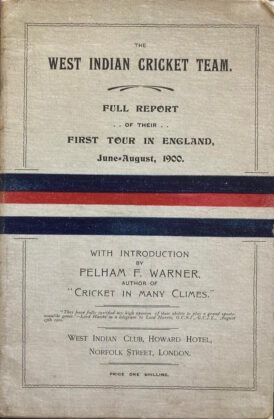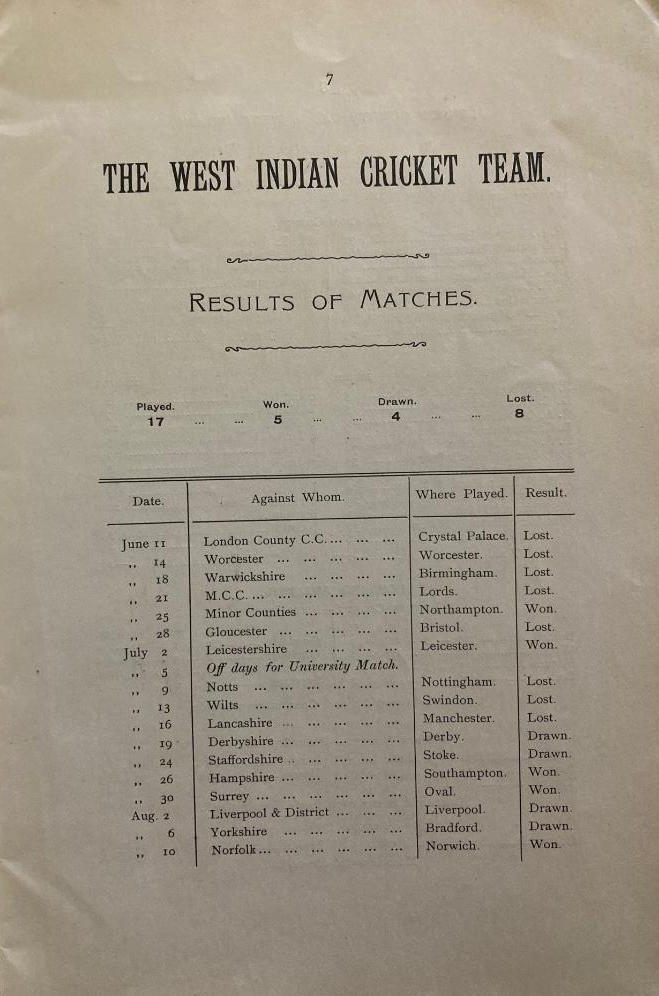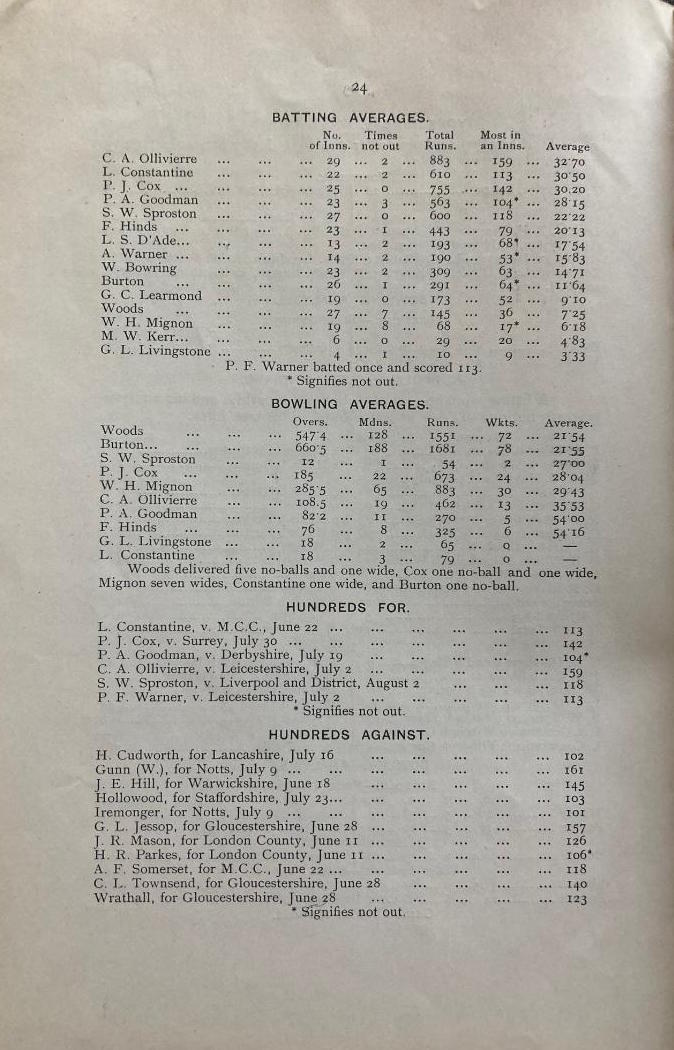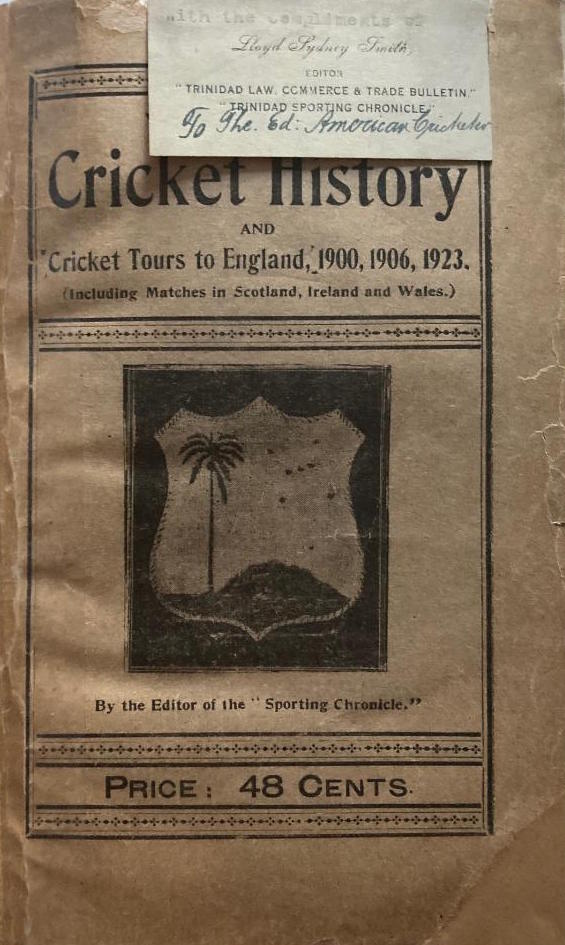A souvenir of a long forgotten tour
Martin Chandler |
The first tour of England by a West Indian side took place in the summer of 1900. The visit lasted from the beginning of June, the first day’s competitive cricket being at the Crystal Palace ground against WG Grace’s London County side, and concluded two months later, the final match being a two day game against Norfolk.
The tourists played 17 matches in all, of either two or three days duration. None of the fixtures were First Class, but the West Indians still faced some strong opposition.
The arrangements for the tour were made by a private club, the West Indian club who, at that time, operated from the Howard Hotel in Norfolk Street in London. One of the club’s stated objects, on formation in 1898, was to afford facilities for organising in connection with the West Indies and British Guiana, annual cricket matches and other kindred amusements recognised by our English Universities and Public Schools.
The subsequent story of the West Indian club would doubtless be an interesting one but, for now, all I am aware of is that closed in the 1970s. If, and I know not whether this is the case, it had never moved from the Howard Hotel then its demise may well have been caused by the hotel’s closure as a result of the demolition of Norfolk Street.
The touring party was led by Aucher Warner, the older (by 14 years) brother of ‘Plum’. There were 15 players, all bar two of them amateurs. Ten of the party were white and just five black. The black players were the two professionals, Tommie Burton and ‘Float’ Woods, as well as Fitz Hines and the two most recognisable names, Lebrun Constantine (father of Learie) and Charles Olliviere (who stayed behind after the tour and qualified to play for Derbyshire).

The opening fixture proved to be something of a mismatch as London County proved far too strong for the tourists, eventually running out winners by an innings and 198 runs. The next three games, against Worcestershire, Warwickshire and the Gentlemen of the MCC were defeats as well, before victory was finally achieved over a Minor Counties XI.
Gloucestershire then handed out another heavy defeat before, thanks in large part to a century from guest opener ‘Plum”, the West Indians defeated Leicestershire. The low point of the tour, an innings defeat to Minor County Wiltshire was still to come, but by and large the West Indians, no doubt in part due to an increasing familiarity with English conditions, became more competitive as the tour progressed and their best performance came at the Oval where they achieved an innings defeat over Surrey. The home side were not at full strength, but it was a significant victory nonetheless.

By the end of the tour the West Indians had won five times, drawn four matches and lost eight and the trip was considered a success. The two leading batsmen had been Ollivierre and Constantine, and the two professional bowlers, Woods and Burton, were the most successful bowlers by a distance, in respect of both average and wickets taken.

The lack of any First Class fixtures makes this tour, despite its wider significance, very much a minor one and no publisher went near it. There is however one contemporary souvenir of the tour, a nicely produced 50 page booklet that was published by the West Indian Club. Unsurprisingly the booklet is a scarce one and copies rarely appear on the market. It is an interesting period piece.
The booklet begins with an overview of the tour by ‘Plum’ which summarises the background to Anglo-West Indian cricket before going on to describe the tour’s progress, and thence to pass judgment on the playing records of the individual West Indians.
Modesty prevents ‘Plum’ making mention of his own contribution against Leicestershire, but his observations can at times be quite sharp. Of Woods he observed that the pace bowler was on occasions up to his best West Indian form, but at other times he seemed to lose heart very easily. Of the batsmen generally one comment is that in the early part of the tour they were both individually, and as a team, the worst judges of a run I have ever seen.
After the Report there is a summary of the results followed by the important business of a scorecard of each match and the tour averages. That takes the booklet to its half way point, and there is some interesting narrative to follow.
To begin with there are a couple of reprints from The Field, a magazine on the subject of countryside pursuits and field sports that remains in print to this day. Both are positive in their reaction to the West Indian visit.
By far the largest part of the booklet however, 23 pages, is devoted to a verbatim account of the speeches and toasts given at the Banquet to the Visitors given by the West Indian Club. There is even a list of the music that was played although, perhaps disappointingly, no menu to inform us as to what the guests dined on.
We do however know who attended, as there is a list of the names of the 57 who did, the evening being chaired by one of English cricket’s grandees, Lord Harris. The West Indian players were present, including Hinds and Ollivierre. Sadly it seems that Woods and Burton, presumably because of their status as professionals, were not there, but there in no explanation for Constantine’s absence – I would like to think there was a principled objection involved.
And so that is that for one of the more unusual items in my collection, but it wasn’t quite the last word on the 1900 tour as, more than twenty years later, a book was published in Trinidad on the subject of the tour, and the next two West Indian tours to England. Written by local journalist Lloyd Sydney Smith I really should get round to reading it.







Leave a comment